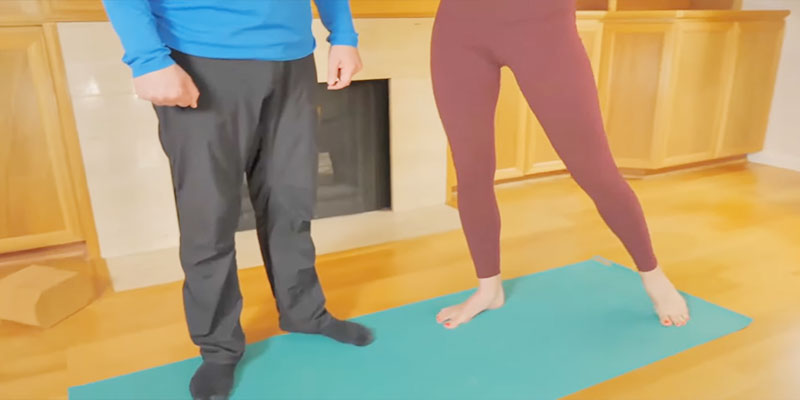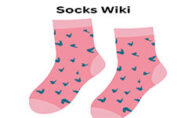Hi, I'm Christopher Bevans, the creator of SocksWiki.com. With a background in fashion design and a passion for innovation, I’m here to share my knowledge on socks from troubleshooting tips to detailed buying guides. I believe the right pair of socks can make all the difference, and through this site, I aim to help you find the perfect fit for every occasion.
Hi, I'm Christopher Bevans, the creator of SocksWiki.com. With a background in fashion design and a passion for innovation, I’m here to share my knowledge on socks from troubleshooting tips to detailed buying guides. I believe the right pair of socks can make all the difference, and through this site, I aim to help you find the perfect fit for every occasion.
Yes, you can wear socks for yoga. From hygiene considerations to grip enhancement and style expression, the choice between bare feet and sock-clad soles reflects individual preferences and practical needs.
Do you wear socks to yoga or not -this is the question of the beginners or even experienced ones! As practitioners navigate their yoga journey, they weigh the benefits and drawbacks of wearing socks during practice.
Now, we will discuss about the nuanced question surrounding the decision to wear socks to yoga, discussing on the diverse perspectives and factors influencing this seemingly simple yet significant choice.
Is It Better to Do Yoga With Socks or Barefoot?
A common question among yoga practitioners is whether it is better to do yoga with socks on or barefoot. The answer largely depends on personal preference, the type of yoga being practiced, and the environment in which it is performed.
Let’s explore the benefits and drawbacks of both options to help you decide what works best for you:
Practicing Yoga Barefoot
Traditionally, yoga is practiced barefoot, and there are some valid reasons for that.
Here are the reasons of doing Yoga in barefoot:
- Better Grip and Stability: Yoga mats are designed to provide a non-slip surface for bare feet. Practicing barefoot allows for better grip, which is essential for maintaining stability in poses like Downward Dog, Warrior, and Tree Pose.
- Enhanced Grounding and Balance: Barefoot yoga allows you to feel a direct connection to the ground, improving proprioception (your sense of body position). This helps with balance and alignment in standing and balancing poses.
- Natural Foot Engagement: When barefoot, the small muscles in your feet are actively engaged, strengthening them over time. This can improve foot health, posture, and overall mobility.
- Tradition and Authenticity: Yoga originated in India, where it has been practiced barefoot for centuries as part of its cultural and spiritual essence.
Practicing Yoga With Socks
While barefoot yoga is the norm, some practitioners may prefer or need to wear socks.
Here’s why:
- Hygiene and Comfort: In public yoga classes or shared spaces, socks can protect your feet from germs and dirt, providing a hygienic barrier.
- Cold Environments: When you’re practicing in a cold studio or during winter, socks can keep your feet warm, preventing discomfort or stiffness.
- Special Yoga Socks: Yoga-specific socks are designed with non-slip grips on the soles, offering stability while reducing the risk of slipping on the mat.
- Medical or Physical Needs: Individuals with certain medical conditions, foot injuries, or sensitivities may find wearing socks more comfortable or necessary.
Things to Consider
- Type of Socks: If you choose to wear socks, opt for non-slip yoga socks to maintain traction. Regular socks may cause slipping, increasing the risk of injury.
- Yoga Style: Dynamic or flow-based yoga styles like Vinyasa or Ashtanga often require firm grounding and stability, making barefoot the better option. For slower styles like Yin or restorative yoga, socks may work just fine.
- Personal Preference: Ultimately, comfort and confidence in your practice are key. Experiment with both options to see what suits you best.
Are Yoga Socks Mandatory?
Yoga socks aren’t mandatory but can be beneficial. Though some practitioners prefer the barefoot connection with the ground, yoga socks offer advantages like grip, warmth, and hygiene, especially in chilly or public studio environments.
They can prevent slips and provide stability during poses, enhancing the practice for those with foot sensitivities or on slippery surfaces.
Ultimately, whether to wear yoga socks is a personal choice, influenced by comfort, preference, and the specific demands of one’s practice.

Do You Wear Socks for Yoga?
Yes, people wear socks to yoga though it is not mandatory for yoga practice.
Wearing socks during yoga practice is a topic that often stirs debate among practitioners. Some swear by the comfort and hygiene benefits, while others argue that it detracts from the connection with the ground and proper alignment.
Here’s a breakdown of reasons why people choose to wear socks during yoga:
Maintaining Hygiene
Practicing yoga in a studio often means sharing the space with others, and the floor can accumulate sweat, dirt, and bacteria. For individuals who are concerned about hygiene, wearing socks provides a protective barrier between their feet and the floor.
This can be particularly important for those with sensitive skin or a compromised immune system. By wearing socks, practitioners can reduce their exposure to potential germs and maintain a cleaner practice environment.
Getting Warmth
In colder climates or during practices in air-conditioned rooms, maintaining warmth can be challenging, especially for extremities like the feet. Wearing socks during yoga can help retain body heat, keeping the feet cozy and comfortable throughout the practice. This added warmth can be particularly beneficial during the initial relaxation phase, where the body is encouraged to release tension and settle into the practice.

Getting Proper Grip
Certain yoga socks are designed with non-slip grips on the bottom, providing traction and stability during poses.
These grips help prevent the feet from sliding on the mat, especially for practitioners with sweaty feet or when practicing on slippery surfaces.
By enhancing grip and stability, yoga socks can support practitioners in maintaining proper alignment and executing poses with greater confidence and ease.
Having Comfort
Wearing socks can offer additional cushioning and support for individuals with sensitive feet or foot conditions such as plantar fasciitis.
The padding provided by socks can help alleviate discomfort and reduce pressure on the feet during weight-bearing poses.
This increased comfort can enable practitioners to focus more fully on their breath and alignment, enhancing the overall yoga experience.
Style
Yoga socks come in a wide range of colors, patterns, and styles, allowing practitioners to express their personality and sense of style on the mat. From vividhues to intricate designs, yoga socks add a fun and fashionable element to the practice.
Additionally, wearing unique socks can serve as a conversation starter and foster a sense of community among practitioners in the studio, further enriching the yoga experience.

Connection with the Ground
Yoga emphasizes the connection between the body, mind, and the earth beneath us. Practicing barefoot allows us to feel the texture, temperature, and energy of the ground, enhancing our sense of grounding and stability.
Wearing socks during yoga creates a layer of insulation between the feet and the earth, diminishing this connection. Without direct contact with the ground, practitioners may find it challenging to root down and find stability in standing poses and balances.
Additionally, the tactile feedback from the earth is essential for proprioception, the body’s awareness of its position in space, which can be hindered by the barrier of socks.
Proper Alignment
Proper alignment is fundamental in yoga to prevent injury and maximize the benefits of each pose. In standing balances like Tree Pose or Warrior III, the placement of the feet and toes is crucial for stability and alignment.
Socks can obstruct the feedback loop between the feet and the brain, making it difficult for practitioners to sense subtle shifts in alignment. Without this feedback, it’s easier to misalign the body, compromising the integrity of the pose and increasing the risk of injury over time.
Practicing barefoot allows for greater proprioceptive awareness, enabling practitioners to adjust and refine their alignment more effectively.

To Avoid Slippage
Though non-slip socks may offer some traction, they may not provide the same level of stability as bare feet or grippy yoga mats.
In poses where a strong foundation is essential, such as Downward Facing Dog or Plank, socks can cause slipping, compromising stability and increasing the risk of injury.
Even with non-slip grips, socks can still shift or bunch up during dynamic movements, further exacerbating the risk of slippage.
Additionally, the reliance on socks for traction can create a false sense of security, leading practitioners to push beyond their limits and potentially strain muscles or joints.
Is It Better To Do Yoga Barefoot or With Socks?
Whether to practice yoga barefoot or with socks is a matter of personal preference, but there are benefits and considerations for both options.
Yoga Barefoot
- Connection to the Earth: Practicing yoga barefoot allows for a direct connection between your feet and the ground, enhancing your sense of stability and grounding during the practice.
- Better Grip: Bare feet often provide better grip on the yoga mat, especially during poses that require balance or traction. This can help prevent slips and falls, particularly in styles of yoga that involve dynamic movements.
- Alignment Awareness: Being barefoot enables you to have better awareness of your foot alignment and engagement. You can spread your toes and activate the muscles in your feet more effectively, which can contribute to better overall posture and alignment in yoga poses.
- Stimulation of Reflexology Points: The soles of the feet have numerous reflexology points that can be stimulated during barefoot yoga practice, potentially enhancing overall relaxation and well-being.
Yoga with Socks
- Hygiene: Wearing socks can help maintain hygiene, especially if you’re practicing in a shared or public space where the floor may not be completely clean. It provides a barrier between your feet and any dirt or germs on the surface.
- Warmth: For some practitioners, wearing socks can provide warmth, particularly in cooler environments or during practices like Yin or Restorative yoga where long holds are involved.
- Comfort: Some people simply find wearing socks more comfortable, especially if they have sensitive feet or if the yoga mat texture feels rough against their skin.
- Injury Prevention: Socks can provide additional cushioning and support, which may be beneficial for individuals with foot pain or certain foot conditions. They can also help prevent blisters or abrasions on the feet, particularly during more intense or vigorous practices.
What Do You Wear on Your Feet for Yoga?
Choosing what to wear on your feet for yoga depends on personal preference, the type of yoga practice, and the environment.
Here are some common options:
Yoga Socks
Yoga socks are specially designed for yoga practice. They typically have grips or traction on the soles to prevent slipping on the mat. Yoga socks can be a good option if you prefer to keep your feet covered for hygiene, warmth, or comfort reasons while still maintaining traction and stability during the practice.
Toe Socks
Toe socks are similar to regular socks but have individual compartments for each toe, resembling gloves for the feet. They provide warmth and can help prevent blisters or abrasions between the toes. Some practitioners find toe socks beneficial for enhancing toe spread and foot alignment during yoga poses.
Yoga Shoes
Yoga shoes are a relatively newer option in the market. They provide a balance between the grip of bare feet and the protection of traditional shoes. Yoga shoes typically have thin, flexible soles that allow for natural movement and sensory feedback while providing some level of protection and support.
Minimalist Shoes
Some practitioners opt for minimalist shoes with thin, flexible soles for their yoga practice. These shoes offer some protection and support while still allowing for a sense of connection with the ground.
However, not all minimalist shoes may be suitable for yoga, so it’s essential to choose ones that allow for freedom of movement and stability.
Frequently Asked Questions
What Are the Best Yoga Socks for Women?
For women, some popular options for yoga socks include brands like ToeSox, Tucketts, and Gaiam. Look for socks with non-slip grips on the soles for added stability during practice.
What Are the Best Yoga Socks for Men?
Men can find suitable yoga socks from brands like Tavi Noir, Lululemon, and Nike. Look for socks with features like arch support and moisture-wicking materials for comfort during practice.
Can I Keep Socks On in a Yoga Class?
Yes, you can keep socks on during a yoga class if you prefer. However, it’s essential to choose socks with grips or traction on the soles to prevent slipping on the mat, especially during dynamic or balancing poses.
Do I Need Grip Socks for Yoga?
Yes, grip socks can be beneficial for yoga, especially if you prefer to keep your feet covered during practice. Grip socks provide traction on the mat, enhancing stability and preventing slips.
They are particularly useful for practitioners who sweat a lot or practice in hot yoga environments.
Do You Wear Socks to Yoga for Beginners?
Whether beginners wear socks to yoga depends on personal preference and comfort. Some beginners may prefer the added grip and stability provided by yoga socks, while others may choose to practice barefoot to improve foot strength and alignment awareness.
Do You Wear Shoes for Hot Yoga?
Most practitioners do not wear shoes for hot yoga. Hot yoga studios typically recommend practicing barefoot to maintain a better connection with the mat and allow the feet to breathe.
Wrap Up
Whether to wear socks during yoga depends on personal preference, comfort, and the specific needs of your practice.
Some practitioners prefer the added grip and stability provided by yoga socks, while others opt for barefoot practice to enhance foot engagement and alignment awareness.
Grip socks can be particularly beneficial for preventing slips on the mat, especially in dynamic or hot yoga classes.
Ultimately, the most important factor is choosing footwear that allows you to move freely, stay balanced, and enjoy the full benefits of your yoga practice, whether that means wearing socks, going barefoot, or using minimalist footwear.

Hi, I'm Christopher Bevans, the creator of SocksWiki.com. With a background in fashion design and a passion for innovation, I’m here to share my knowledge on socks from troubleshooting tips to detailed buying guides. I believe the right pair of socks can make all the difference, and through this site, I aim to help you find the perfect fit for every occasion.
- Latest Posts by Christopher Bevans
-
Socks Care Label Symbols and Meanings: 5 Explained
- -
Smartwool vs Darn Tough Socks: Hiking, Running, Women & Men
- -
Socks Storage Ideas: 10 Real-Life DIY Ideas
- All Posts


